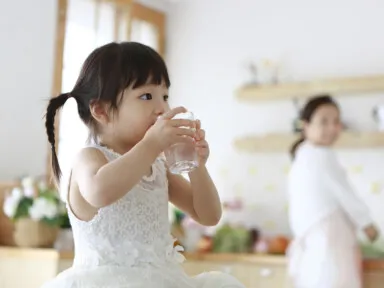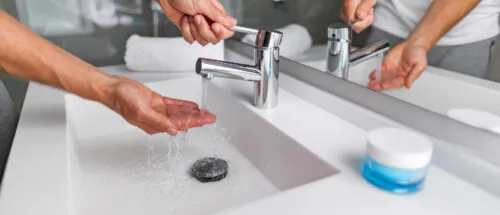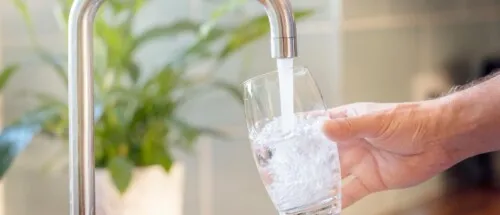Water is an essential nutrient for all life. It’s the foundation of our children’s growth and well-being. With infants’ bodies comprising 75% water, ensuring they have access to clean, safe water is a crucial part of nurturing their development. As parents, you’re committed to safeguarding your children every day, and getting them enough water is a top priority. But with the complexities of water quality and potential contaminants like lead and nitrates, how can you be sure your tap water is safe to drink?
At Leaf Home, we’re committed to empowering you with the knowledge and tools to protect your family’s health. From identifying key challenges in the U.S. water supply to contaminants that pose risks to kids, we’re here to guide you on your journey to ensure your kids have access to safe drinking water. Let’s explore practical solutions that will keep your children hydrated and healthy.
Is Tap Water Safe to Drink?
The U.S. has one of the safest drinking water supplies in the world, thanks to the Safe Drinking Water Act of 1974. This pivotal legislation gave the Environmental Protection Agency (EPA) the authority to set and enforce rigorous standards for public water systems.
For families relying on the public water system, rest assured your water is treated for contaminants before it reaches your faucet. With standards for over 90 potential contaminants, the EPA ensures that the water you provide to your children is clean and safe. On the other hand, bottled water is regulated by the Food and Drug Administration (FDA) as a food product, which involves different safety protocols.
Understanding these distinctions helps you make informed decisions about your family’s water consumption.
Problems with Drinking Water
While serious drinking water contaminants are rare and usually temporary, they can occur. Most of these contaminants enter the water supply due to treatment problems or extreme weather events. In the U.S., municipal water systems draw from rivers, lakes, or groundwater wells. When these water sources become heavily contaminated, treatment becomes difficult.
The situation in Flint, Michigan, serves as a stark reminder of the potential health impacts of contaminated water. In 2014, Flint switched its water supply to the polluted Flint River, resulting in residents suffering from skin rashes, hair loss, and itchy skin. Later studies revealed alarming increases in blood lead levels among local children. Researchers at Johns Hopkins Bloomberg School of Health estimate that 68% of children in Chicago under 6 years old live in households with tap water showing detectable lead levels.
However, most contaminants in the U.S. water supply are not at levels considered unsafe for children. Microbial contamination, such as bacteria and viruses, is the primary concern due to its potential to cause immediate reactions like vomiting and diarrhea. Lead and nitrates also warrant testing, given their serious developmental risks to pregnant women, newborns, and young children.
Contaminants Children May Be Particularly Susceptible
Understanding your water quality is critical as a parent since children consume more water relative to their size compared to adults. Young children’s immune systems are still developing, making them more susceptible to microbes in drinking water. Diarrhea and vomiting can lead to dehydration more quickly for kids than adults. The Center on the Developing Child at Harvard University finds children are more vulnerable to chemical contaminants that could impact their learning, motor skills, and hormonal development during crucial stages of growth.
The EPA has established standards to protect the most vulnerable populations, including children. Key areas where children are particularly at risk and where the maximum contaminant level (MCL) is based explicitly on their vulnerability include lead, nitrates, and nitrites. The MCL is the highest allowable concentration of a specific contaminant in drinking water.
Why is Lead so Harmful?
Lead poses a significant risk to infants and children due to its neurotoxic effects. Long-term exposure can lead to irreversible physiological and neurological damage. Even minimal lead levels in the bloodstream can result in:
- Learning and behavioral issues
- Lower I.Q. and increased hypersensitivity
- Stunted growth and development
- Hearing and speech difficulties
- Anemia
Dangers of Nitrates and Nitrites to Children and Babies
Nitrates, which partly convert to nitrites in the bloodstream, impede red blood cells from carrying oxygen. Infants under 12 months old are at risk of developing methemoglobinemia, or blue baby syndrome, when drinking formula made with nitrate-contaminated water. This condition turns the skin blue due to insufficient oxygen. Private well water sources are most susceptible to nitrate contamination. Symptoms of nitrate contamination include:
- Breathing difficulties
- Vomiting
- Diarrhea
- Seizures
- Loss of consciousness
In addition to lead, nitrates, and nitrites, you will want to test for the following harmful substances in tap water to keep your children safe.
Additional Contaminants of Concern
Heavy Metals to Avoid
Though less common in drinking water, metals like arsenic, mercury, cadmium, and chromium are harmful to early development. These metals can enter the water supply through natural mineral deposits, industrial activities, and plumbing systems.
Pesticides
Chronic pesticide exposure can seriously affect children’s neurological development and weaken their immune system’s infection-fighting capabilities.
Coliform Bacteria
Coliform bacteria are the most common cause of waterborne illness in both adults and children. Kids, with their developing immune systems, are more susceptible to illnesses such as:
- Upset stomach
- Flu-like symptoms
- Diarrhea
- Vomiting
- Fever
- Abdominal cramps
- Nausea
- Headaches
- Fatigue
Bacterial contamination is more prevalent in well water compared to public water supplies. Public systems are legally obligated to issue a boil water advisory if coliform bacteria are detected.
How to Protect Your Children’s Water Supply
Ensuring your children’s tap water is safe to drink is achievable with a few proactive measures. Here’s how you can safeguard their water supply:
Check Your Local Water Supply Reports
Start by reviewing your local water company’s annual water quality report. These reports are mandated by law and provide insights into potential contaminants. The EPA sets stringent standards aimed at protecting vulnerable populations, including fetuses, infants, and children, by assessing the risks these groups face compared to the general population.
Test Your Water
Understanding what’s in your water is the first step to addressing any issues. Professional water tests offer the most accurate readings, identifying contaminants that many store-bought kits might miss.
Leaf Home Water Solutions provides complimentary home water testing during every consultation. You’ll receive results within minutes, followed by tailored solutions from our water experts to meet your specific needs.
Install a Water Treatment System
With your water test results in hand, you can choose a whole-home water filtration system that suits your requirements. Reverse osmosis systems are highly effective for home water filtration, though they may come with a higher price. The type of water treatment system you will need depends on the specific contaminants identified in your water.
Ensure any water treatment system you select is certified by the National Sanitation Foundation (NSF) or American National Standards Institute (ANSI), both of which are globally recognized for ensuring product safety and quality.
Consider these water treatment systems according to the contaminants they address:
- Water Softeners Systems: Also known as ion exchange systems, this system swaps unwanted ions with less harmful ones. It is used for water purification and softening and is best suited for nitrates, nitrites, fluoride, sulfate, and boron.
- Reverse Osmosis (RO) Systems: These systems push water through a semipermeable membrane, filtering out a wide range of contaminants. They are ideal for nitrates, nitrites, lead, arsenic, and PFAS.
- Ultraviolet (UV) Systems: UV systems use light to neutralize bacteria and viruses present in water. They are most effective for eliminating coliform bacteria. UV systems are an ideal add-on when filtration alone does not work.
- Activated Carbon Filtration: This method uses carbon filters to trap and reduce contaminants. It is particularly effective for removing lead, pesticides, and compounds that cause bad taste and odor.
- Nanofiltration: A finer filtration process that removes smaller particles, including some chemicals and PFAS. Best suited for PFAS.
Implementing these strategies can help ensure the water your children drink is as safe and clean as possible.
How to Make Sure Well Water is Safe
Owning a private well or aquifer comes with the responsibility of ensuring your water is safe for your family. Since the U.S. Environmental Protection Agency doesn’t monitor or treat private wells, it’s up to you to regularly test and treat your water supply.
Importance of Regular Testing
Remember, many dangerous contaminants are invisible—colorless, odorless, and tasteless. Therefore, testing your water is critical to detect if well water is safe to drink. It is recommended to test for nitrates and coliform bacteria annually, as these are common and pose significant health risks. Test more frequently if you suspect potential contaminants like radon, pesticides, or industrial chemicals are present. Knowing what water contamination symptoms look for allows you to address potential issues early on.
Using EPA Standards
Following EPA drinking water standards provides a reliable guideline for maintaining safe drinking water, especially for children. These standards help ensure that your well water meets the safety criteria for protecting your family’s health.
Quality Water for Childhood Development
Access to clean and safe drinking water is vital for your child’s health and development. Contaminants like lead, nitrates, pesticides, and bacteria can pose significant risks, but with informed steps, these threats can be managed. Regularly testing your water, understanding the contaminants, and implementing effective water treatment solutions are crucial in preventing waterborne illnesses and chronic conditions.
Take charge of your family’s health today—schedule a free water test with Leaf Home. Our experts are here to help you achieve peace of mind with tailored well water safety solutions.



